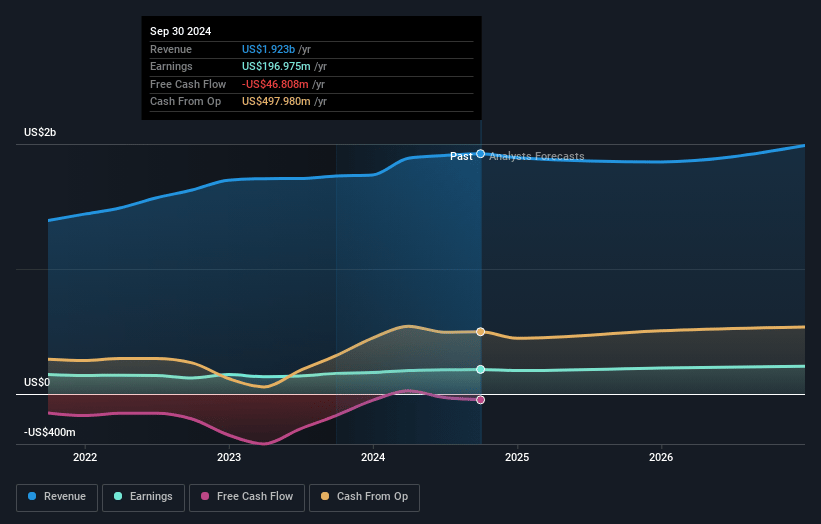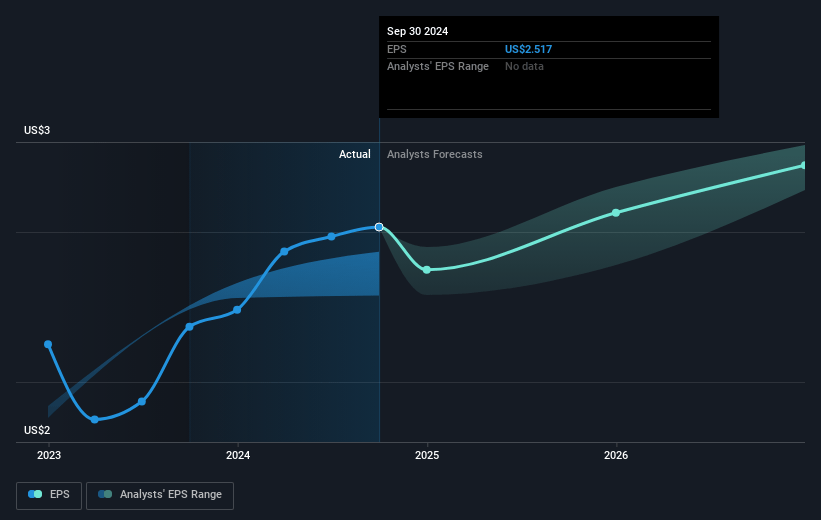Key Takeaways
- Improved rate case results and strategic investments are expected to boost net margins, earnings, and revenue growth.
- Legislative actions and wildfire strategies aim to lower costs, enhancing financial resilience against catastrophic events.
- Rising power supply costs and regulatory challenges pose persistent risks to Avista's earnings, with financial strain from ERM denying rate adjustments and volatile investments.
Catalysts
About Avista- Operates as an electric and natural gas utility company in the United States.
- The conclusion of the Washington general rate case, with an increased return on equity to 9.8%, is expected to improve net margins and provide higher earnings for shareholders.
- The completion of the North Plains Connector, which will expand access to new generation markets, is anticipated to enhance revenue through improved regional reliability and resource adequacy.
- The issuance of an all-source RFP for up to 375 megawatts of generation by 2029 presents opportunities for revenue growth via expanded generation capacity and potential ownership options.
- Legislative efforts and improved wildfire mitigation strategies are expected to reduce costs and enhance net margins by minimizing the financial impact of catastrophic events.
- A planned capital expenditure of $3 billion from 2025 through 2029 supports a projected annual earnings growth rate of 4% to 6%, driven by infrastructure investments and new customer acquisition.
Avista Future Earnings and Revenue Growth
Assumptions
How have these above catalysts been quantified?- Analysts are assuming Avista's revenue will grow by 1.1% annually over the next 3 years.
- Analysts assume that profit margins will increase from 9.3% today to 11.8% in 3 years time.
- Analysts expect earnings to reach $236.7 million (and earnings per share of $2.87) by about March 2028, up from $180.0 million today. The analysts are largely in agreement about this estimate.
- In order for the above numbers to justify the analysts price target, the company would need to trade at a PE ratio of 17.7x on those 2028 earnings, which is the same as it is today today. This future PE is lower than the current PE for the US Integrated Utilities industry at 21.7x.
- Analysts expect the number of shares outstanding to grow by 2.48% per year for the next 3 years.
- To value all of this in today's terms, we will use a discount rate of 6.21%, as per the Simply Wall St company report.
Avista Future Earnings Per Share Growth
Risks
What could happen that would invalidate this narrative?- Rising power supply costs, particularly due to poor hydro conditions and power supply costs, pose a risk to Avista’s future earnings. This is compounded by denied proposed modifications to the energy recovery mechanism (ERM) by the Washington Commission. Such financial factors may impact net margins negatively.
- The ERM continues to be a potential financial burden, with Avista incorporating a $0.12 negative impact from the ERM into its base earnings guidance for 2025, indicating potential pressure on earnings due to higher net power supply costs versus those included in base customer rates.
- Volatility and losses from non-utility business investments are another risk factor, with a loss of $0.09 per diluted share in 2024 arising from early-stage investments and borrowing costs. Such investment losses can impact earnings if no offsetting gains are realized.
- The complexity and uncertainty of regional energy markets, driven by extreme weather events, carbon emission policy, and the integration of renewables, increase forward market uncertainty, which can adversely affect forecasted and actual revenue and profitability.
- Settlement risks and the variability of regulatory outcomes in multiple jurisdictions can result in lumpy financial performance, impacting predictable revenue and profit growth due to variations in case outcomes and required rate adjustments.
Valuation
How have all the factors above been brought together to estimate a fair value?- The analysts have a consensus price target of $40.6 for Avista based on their expectations of its future earnings growth, profit margins and other risk factors. However, there is a degree of disagreement amongst analysts, with the most bullish reporting a price target of $49.0, and the most bearish reporting a price target of just $36.0.
- In order for you to agree with the analyst's consensus, you'd need to believe that by 2028, revenues will be $2.0 billion, earnings will come to $236.7 million, and it would be trading on a PE ratio of 17.7x, assuming you use a discount rate of 6.2%.
- Given the current share price of $39.65, the analyst price target of $40.6 is 2.3% higher. The relatively low difference between the current share price and the analyst consensus price target indicates that they believe on average, the company is fairly priced.
- We always encourage you to reach your own conclusions though. So sense check these analyst numbers against your own assumptions and expectations based on your understanding of the business and what you believe is probable.
How well do narratives help inform your perspective?
Disclaimer
Warren A.I. is a tool utilizing a Large Language Model (LLM) that ingests data on consensus price targets, forecasted revenue and earnings figures, as well as the transcripts of earnings calls to produce qualitative analysis. The narratives produced by Warren A.I. are general in nature and are based solely on analyst data and publicly-available material published by the respective companies. These scenarios are not indicative of the company's future performance and are exploratory in nature. Simply Wall St has no position in the company(s) mentioned. Simply Wall St may provide the securities issuer or related entities with website advertising services for a fee, on an arm's length basis. These relationships have no impact on the way we conduct our business, the content we host, or how our content is served to users. The price targets and estimates used are consensus data, and do not constitute a recommendation to buy or sell any stock, and they do not take account of your objectives, or your financial situation. Note that Warren A.I.'s analysis may not factor in the latest price-sensitive company announcements or qualitative material.




